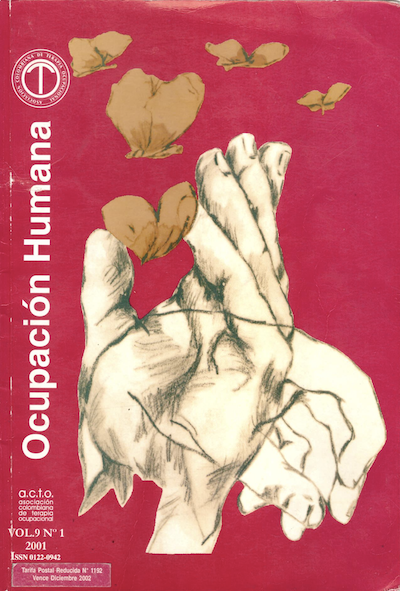Modelo automatizado para prescripción del sistema de silla de ruedas “MAPSI”
DOI:
https://doi.org/10.25214/25907816.526Palabras clave:
mapsiResumen
Este trabajo de desarrollo tecnológico tuvo como objetivo diseñar y elaborar un manual que operacionalizara, sistematizara y optimizara la prescripción del sistema de sillas de ruedas. Se realizó en cuatro etapas: Identificación de la situación actual de la prescripción de sillas de ruedas en Colombia; diseño de la guía metodológica; recolección de información para la base de datos y, desarrollo del sistema experto. El resultado del trabajo fue el MAPSI que se compone de: 1. Procedimientos de Prescripción, es una guía metodológica, incluye Instrumento de Prescripción, y 2. Sistema Experto UN-PRESCRIPTOR DEL SISTEMA DE SILLA DE RUEDAS que almacena en una base de datos información de sillas de ruedas y accesorios disponibles en el mercado nacional, recibe y procesa los datos del usuario e imprime la prescripción final.
Descargas
Referencias bibliográficas
ALCO SALES & SERVICE Co. Catalog, http://alcosales.com. 1996.
AMERICAN OCCUPATIONAL THERAPY ASOCIATION. http://www.aota.org. 1998.
Bailey, Diana y Defelice, Tricia. Evaluating movement for switch use in an adult with severe physical and cognitive impairments. En: The American Journal of Occupational Therapy. Vol. 45, No. 1, (June 1991); pp. 76 -79.
https://doi.org/10.5014/ajot.45.1.76
Bain, Beverly K. Asistive technology. En: Willard and Spademan's Occupational Therapy, H.L. Hopkins and H.D. Smith 1993. Pp. 325-340.
Bednarczyk, Janet y Sanderson, David. Kinematics of Wheelchair propulsion in adults and children with spinal cord injury. En: Arch Phys Med. Rehab. Vol. 75 (December 1994). Pp. 1.327-1.334.
Berhman, Andrea L. Factor in functional assessment. En: Journal of Rehabilitation Research and Development, Clinical Supplement No. 2: Choosing a Wheel chair System. Vol. 25. No. 2 (October 1990); pp. 17-30.
Bergen, A. E y Colangelo, C. Positioning the client with nervous system deficits: The wheelchair and other adaptive equipment. 2 Ed. Valhalla. N.Y.: Valhalla Re habilitation, s.f., pp. 3-60.
Brubaker, Clifford. Ergonometric considerations. En: Journal of Rehabilitation Research and Development, Clinical Supplement No. 2: Choosing a Wheelchair System. Vol. 25. No. 2 (October 1990); pp. 37-48.
Cabezas Conde, Guillermo. Arquitectura para todos: Manual para proyectar sin barreras arquitectónicas. Bogotá: Italgraf, 1991. pp. 1-12.
Cutter| Nancy y Blake, Donnajo. Wheelchairs and seating systems: Clinical application En: Physical Medicine and Rehabilitation: State of the Art Reviews. Vol. 11, Nó. 1, (February 1997), pp. 107-132.
Deitz, J. y Deudgeron, B. Wheelchair selection process. En: TROMBLY A. C. Occupational therapy for physical dysfunction. 2 Ed. Baltimore / London : William and Wilkins, 1995. Pp. 599-608.
DISABLED LIVING FOUNDATION. Classification listing for 13 manual wheelchairs ¡on 28 July 95. London: s.n., 1995.
DMA Ltd. Catalogue. S.I.: s.n., s.f.
Everest & Jennings. Catalogue Everest & Jennings Avenues. Caramarillo: s.n., 1996. 48 p.
Everest & Jennings. Catalogue. USA : Libby's Lithograph; (December 1981) 36 p.
Feguson-Pell, Martin W. Seat cushion selection. En: journal of Rehabilitation Research and Development, Clinical Supplement No. 2: Choosing a Wheelchair Systerft. Vol. 25. No. 2 (October 1990), pp. 49-73.
Galvin, Jan C. y Scerer, Marcia J. Evaluating, selecting and using appropriate assistive technology. Gaithersburg, Maryland: Asper Publishers, Inc. 1996; pp. 1-77i1
Garber, Susan y Dyerly, Linda. Wheelchair cushions for persons with spinal cord injury: An update. En: The American Journal of Occupational Therapy. Vol. 45, No. 6, (June 1991), pp. 550-554).
https://doi.org/10.5014/ajot.45.6.550
Garber, Susan y Krouskop, Thomas. Technical advances in wheelchairs and seating systems. En: Physical Medicine and rehabilitation : State of the Art Reviews. Vol. 11, No. 1, (February 1997), pp. 93-103).
Garber, Susan y Krouskop, Thomas. Wheelchair cushions modification and its effect on pressure. En: Arch Phys Med. Rehab. Vol. 65, (October 1984), pp. 579- 583.
Gendron, INC. Economy Series. Folding Wheel Chair Model. Por Gendron, Ohio, 1979.
Gendron, INC. Standard foot rest and accessories. Por Gendron, Ohio, 1980.
Hagerdorn, Rosemary. Occupational Therapy: Foundations for practice. New York: Churchill Livingstone, 1992. 104 p.
Hale, Gloria. Manual para Minusválidos. Madrid: Blume, 1980. Pp. 14-25.
Hallenborg, Susan C. Equipment prescription on services. Billeria: M. Ed., 1984. Pp. 17-19.
https://doi.org/10.1108/eb042070
INVACARE CORPORATION. Home page. Hppt//:www.Invacare.com. 1997.
Jonhson Taylor, Susan. Evaluating patient for wheelchair. En: American Journal of Occupational Therapy. Vol. 41, No. 11 (November 1987). Pp. 711-716.
https://doi.org/10.5014/ajot.41.11.711
Jonhson Taylor. Focussing Backwards: How to look for a back support. En: Jay Medical Wheelchair Seating Update. S.I.: Fall. 1994. Pp. 4-17.
Kitamura, Jun-ichi y Nakagawa, Hirofumi. Visual influence on contact pressure of hemiplegic patients through photoelastic sole image. En: Arch Med. Rehab. Vol. 77, (January 1996), pp. 14-18.
https://doi.org/10.1016/S0003-9993(96)90213-0
Koo, Terry; Mak, Artur; y Lee L. Posture effect on seating interface biomechanics: Comparison between two seating cushions. En. Arch Med. Rehab. Vol. 77, (January 1996), pp. 40-47.
https://doi.org/10.1016/S0003-9993(96)90218-X
Lamport, Nancy K.; Coffey, Margaret S. y Hersch, Gayle. Activity analysis and application: Building blocks of the treatment. 3 Ed. Thorofare - USA: Slack, 1996. Anexo C.
Laserna, R. Apuntes de la asignatura Principios Tecnológicos. Universidad Nacional. Santa Fe de Bogotá, 1997.
Mann, William C. y Lane, Joseph. Assistive technology for persons with disabilities: The role of occupational therapy. Rockville, Maryland. American Occupational Therapy Association, 1991. Pp. 74-90.
MICROSOFT CORPORATION. Visual basic: Programming system for windows version 3.0. USA: Microsoft Corporation, 1993. 713 p.
MICROSOFT CORPORATION. The windows interface guidelines for software design. Redmond, Washington: Microsoft Press, 1995. 556 p.
MINISTERIO DE SALUD REPÚBLICA DE COLOMBIA. Lineamientos de atención en salud para las personas con deficiencia, discapacidad y/o minusvalía. Santafé de Bogotá: ASCOPAR, 1996. 59 p.
Mosey, D. Psychosocial components of occupational therapy. N.Y.: Raven, 1986. P 933. Citado por: BAIN, Beverly K. Assistive technology. En: Willard and Spackman's Occupational Therapy. H.L. Hopkins and H.D. smith 1993. P 325- 340.
Okoye, Renee. Computer applications in occupational therapy. En: Willard and Spackman's Occupational Therapy. H.L. Hopkins and H.D. smith 1993. Pp. 341- 366.
Ozer, Mark N. A participatory planning process for wheelchair selection. En: Journal of Rehabilitation Research and Development, Clinical Supplement No. 2: Choosing a Wheelchair System. Vol. 25. No. 2 (October 1990), pp. 31-36.
Philips, Lynn y Nicosia, Angelo. An overview... with reflections past and present of a consumer. En: Journal of Rehabilitation Research and Development, Clinical Supplement No. 2: Choosing a Wheelchair System. Vol. 25. No. 2 (October 1990), pp. 1-7.
Post, Katherine. The promise of assistive technology. En: The American Journal of Occupational Therapy. Vol. 47, No. 11, (November 1993), pp. 965-969.
https://doi.org/10.5014/ajot.47.11.965
QUICKIE DESIGNS INC. Catalogue. USA: Recycled Paper. 1996.
QUICKIE DESIGNS INC. Quickie's Home page. Hppt//:www.blvd.com/quickie.
Ragnarson, Kristian T. Prescription consideration and a comparison of conventional and lightweight wheelchair. En: Journal of Rehabilitation Research and Development, Clinical Supplement No. 2: Choosing a Wheelchair System. Vol. 25. No. 2 (October 1990), pp. 8-16.
RED DE SOLIDARIDAD SOCIAL; PONTIFICIA UNIVERSIDAD JAVERIANA y ECOPETROL. Un entorno accesible para la vivienda independiente. Santafé de Bogotá: Javegraf. 1996. 49 p.
Reed Kathyn y Sanderson, Sharon. Concepts of occupational therapy. 2 Ed. Baltimore/London: William and Wilkins, 1983.f
Renwich, Rebecca M. A model of database design. En: The American Journal of Occupational Therapy. Vol. 45. No. 9 (September 1991), pp. 827-832.
https://doi.org/10.5014/ajot.45.9.827
REPÚBLICA DE COLOMBIA - GOBIERNO NACIONAL. La reforma de la seguridad social en salud: Decretos y Reglamentos: Capítulo III. Ley 100 de 1993.
REPÚBLICA DE COLOMBIA - GOBIERNO NACIONAL. Ey 361 de 1997. Gaceta del Congreso 18; (febrero de 1997), pp. 53-60.
Scott, Anna Deanne. Wheelchair measurement and prescription. En: TROMBLY A. C. Occupational therapy for physical dysfunction. 2 Ed. Baltimore/London: William and Wilkins, 1995. Cap. 14.
Senn, James. Análisis y diseño de sistemas de información. 2 Ed. México: McGraw- Hill, 1992. 942 p.
Smith, Roger. Technological approaches to performance enhancement. Cap. 26. S.l, s.n., s.f.
Smith, Roger y Hammel, Joy. The development of technology competencies and training guidelines for occupational therapist. En: American Journal of Occupational Therapy. V. 47, No. 11, (November 1993), pp. 970-979.
https://doi.org/10.5014/ajot.47.11.970
Trefler, Elaine. Nationally speaking technology applications in occupational therapy. En: American Journal of Occupational Therapy. V 41, No. 11, (November 1993), pp. 679-700.
https://doi.org/10.5014/ajot.41.11.697
Trombly, A. C. Spinal cord injury. En. Trombly A. C. Occupational therapy for physical dysfunction. 2 Ed. Baltimore/London: William and Wilkins, 1995. 511 p.
Trujillo, Alicia. Desempeño ocupacional realizante: Un modelo sobre los propósitos de terapia ocupacional. En: Revista Ocupación Humana. Vol. 6, No. 2 (1995), p. 11- 22.
UNIVERSAL ORTHOPEDIA PORTUGAL. Catálogo. Sociedad Industrial de Ortopedia. Lisboa: s.n., s.f.
UNIVERSITY OF WISCONSIN, Trace R&D Center; UNIVERSITIY OF ARCANSAS FOR MEDICAL CIENCE, Department of physical medicine and rehabilitation and Learning Express inc. ABLEDATA. Version 3. 1996.
Vermeiren, Gustaaf. Eurostyle wheelchairs. Belgium: N.V. Vermeiren, s.f.
Warren C., Gerald. Powered mobility and its implications. En: Journal of Rehabilitation Research and Development, Clinical Supplement No. 2: Choosing a Wheel chair System. Vol. 25. No. 2 (October 1990), pp. 74-85.
Webster, Jefrey S. Et al. Rightward orienting bias, wheelchair maneuvering, and fall risk. En: Arch Phys Med. Rehab. Vol. 76, (October 1995), pp. 924-928.
https://doi.org/10.1016/S0003-9993(95)80068-9
Wilson, Bennett Jr. Wheelchairs: A prescription guide. 2° Ed. N.Y. Demos, 1992. Pp. 7-46.
Descargas
Publicado
Cómo citar
Número
Sección
Licencia

| Estadísticas de artículo | |
|---|---|
| Vistas de resúmenes | |
| Vistas de PDF | |
| Descargas de PDF | |
| Vistas de HTML | |
| Otras vistas | |











